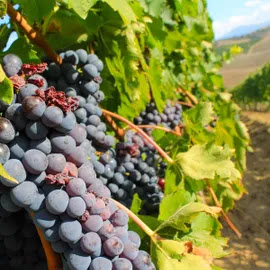When I first got interested in wine, one of the terms I learned was “vintage.” I realized quickly that a vintage wine was nothing like a vintage car. For one, almost every still (vs. sparkling) wine you see in a regular grocery store is a vintage wine. Not true about cars in a regular car dealership.
 |
| Vintage Car by Cayton Heath on Unsplash |
Vintage refers to the year grapes were harvested to make a wine. Let’s delve into why vintage matters and also explore two other terms: non-vintage and solera.
Vintage
Most traditional wine regions are located between the latitudes of 30° to 50°, both north and south of the equator. The climate is generally classified as temperate, with sub-categories of continental, maritime, and Mediterranean. These vineyards go through a one-year cycle from bud break, flowering, fruit set, veraison or ripening, and finally harvest before returning to winter dormancy. Because grapes are only harvested once a year, identifying wine by its vintage makes sense. It gives you an idea of the age of the wine. Some wines are meant to be enjoyed young, and others require cellaring.
 |
| Harvest by Andrea Cairone on Unsplash |
Each wine vintage reflects a culmination of factors during the growing season. The weather pattern for a particular year may affect the flavor, acidity, and sugar of the grapes. Unseasonably hot or cold weather may cause grapes to ripen prematurely without developing full flavors, or not ripen at all. A dry or rainy harvest season may concentrate or dilute the grape juice. Other numerous factors include an untimely windstorm or proximity to forest fires; all of which affect the quality of the finished wine.
The bottom line is that grapes are an agricultural product. As such, they are grown at the mercy of their environment. While modern science and technology has allowed wineries to do vineyard damage control due to force majeure, good wine still starts with good grapes. When the stars are aligned in the vineyards to produce high quality grapes in a particular year, that year is then considered a good vintage.
Non-Vintage
Non-vintage wines are made with grapes that are not harvested in the same year. The most common non-vintage wine is house-style Champagne, often indicated by “NV” on the label. Champagne houses generally make two types of sparklers - vintage and non-vintage. Vintage Champagnes are only made if the growing condition for that year produces outstanding grapes. Over 90% of the Champagnes produced are non-vintage.
 |
| Moët & Chandon NV Champagne |
NV Champagnes usually consist of a blend of 50-80% base vintage with reserves from other vintages. They are often less expensive than their vintage counterparts and provide a consistent style that you may expect from a particular house. It is important to note that NV Champagnes do not taste identical from year to year. House style simply refers to consistent characteristics such as yeastiness vs. fruit forwardness or crisper vs. rounder mouthfeel.
 |
| Grapes are harvested up to 3 times a year in Bali |
More recently, a different flavor of non-vintage has emerged from non-conventional wine regions, such as Tahiti and Indonesia. In these tropical wine regions, vineyards do not experience winter dormancy, and harvests can take place two to three times a year. This new phenomenon challenges the traditional concept of “vintage.” You will find that the wine labels from these regions do not indicate a vintage.
Solera
Solera is a method of aging wines or spirits that originated with aging sherry over multiple vintages. To institute a solera system, you start with the oldest vintage at the bottommost row of barrels, known as the solera (see diagram below). The row of barrels above the solera is called the first criadera, and it contains the next oldest vintage. The next row up is called second criadera, and it contains the third oldest vintage, and so forth. The topmost row of barrels are always filled with the newest vintage.
 |
| Solera Method by Denkhenk via Wikimedia Commons |
 |
| Paul Prieur et Fils Sancerre Rosé Perpétuel |
Solera is one of the ways used to produce NV Champagnes. More recently, I came across an NV Sancerre rosé that was made using the solera method. Sancerre is mostly known for its white wine made from Sauvignon Blanc. I also have had Sancerre Rouge that is made with Pinot Noir. Blanc or Rouge, I had only had vintage Sancerre until then. This Paul Prieur et Fils Rosé Perpétuel was a triple first for me (Sancerre rosé, non-vintage, made using solera method), and it was delicious.
Final Thoughts: Vintage wine makes up most of the still wine volume. Non-vintage wine makes up most of the sparkling wine volume, and some of these are made in the solera method. I wonder if the ratios will change in the coming years - perhaps due to climate change or maybe a new generation of more experimental winemakers. Here’s to toasting to a future of surprises.




























